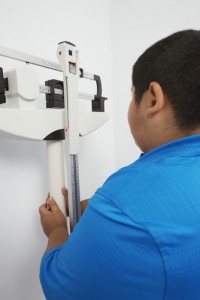That perception needs to change, though. A group of sickle cell specialists from hospitals in New England—members of the 11 institutions in the New England Pediatric Sickle Cell Consortium (NEPSCC)—recently made a surprising observation: Nearly a quarter of children with SCD are overweight or obese. The question is, why?
The answer may start with their red blood cells (RBCs).
“RBCs normally live 120 days,” says Matthew Heeney, MD, clinical director of the Blood Disorders Center at Dana-Farber/Boston Children’s Cancer and Blood Disorders Center and an NEPSCC member. “In sickle cell, RBCs only last 1 to 2 weeks, leaving children with the disease profoundly anemic, with very low hemoglobin levels.”
The body responds, Heeney explains, by ramping up the activity of the bone marrow to keep up with the losses. “The marrow uses up a lot of energy churning out more red blood cells. That’s energy that would normally go into growth and puberty.”
As a result, children with SCD historically have tended to be shorter and thinner.
But a few years ago, Heeney and his NEPSCC colleagues started noticing children in their clinics who didn’t fit that profile. For instance, Heeney spends one week each summer at the Hole in the Wall Gang Camp, a summer camp for children with serious illness, and noticed a rise in the number of obese children with SCD.
At the same time, his NEPSCC colleague Anjulika Chawla, MD, from Hasbro Children’s Hospital, was proposing a screening protocol for avascular necrosis—a debilitating bone deterioration seen in children with SCD—for which obesity was one of the eligibility criteria.
“One of the reviewers said, ‘There’s no such thing as obesity in SCD.’ But when I spoke to colleagues at an NEPSCC meeting, everyone was seeing one or two morbidly obese children. I currently see a couple that weigh over 300 pounds.”In their first joint research foray, six consortium members decided to organize a multicenter study of obesity in SCD, pooling clinical records from six NEPSCC member hospitals between 2007 and 2009. As reported recently in Pediatrics, they came to a surprising conclusion: The obesity rate among the children in the study was 22.5 percent, exceeding the 17 percent rate seen in among children in the United States in general.
The next surprise came when trying to identify risk factors: For every 1 gram per deciliter increase in a child’s baseline hemoglobin level, that child’s obesity risk rose 36 percent.
A side effect of success?
It’s possible that what Heeney, Chawla and their colleagues are seeing represents a side effect of success. Over the last two decades, hematologists have increasingly prescribed a drug called hydroxyurea for children with SCD—based largely on pioneering work by David Nathan, MD, past physician-in-chief of Boston Children’s and president of Dana-Farber Cancer Institute, and Orah Platt, MD, chief of laboratory medicine at Boston Children’s. Originally devised as a chemotherapy agent, hydroxyurea causes the bone marrow to make RBCs carrying fetal hemoglobin, a type of hemoglobin we produce early in life that’s not affected by the sickle-cell mutation.
According to Heeney, hydroxyurea increases the average lifespan of these childrens’ RBCs to about two weeks, taking some of the burden off the bone marrow and reducing the amount of energy siphoned away from other functions—like growth. Both Chawla and Heeney estimate that the number of children with SCD taking hydroxyurea nationally, while low at about 5 to 10 percent, is rising.
“This is a cautionary tale,” says Patricia Kavanagh, MD, MSc, an NEPSCC member, a pediatrician at Boston Medical Center and one of Heeney and Chawla’s co-authors on the study. “What we’re seeing could be a consequence of the fact that the treatment is working.
“We need to make people aware that as we improve the treatments for children with sickle cell, we should be mindful of the nutritional counseling we give them and their parents,” she continues.Chawla adds that the culture around physical exercise in SCD needs to change as well. “We hear families tell children, ‘You can’t keep up with kids on the basketball court,’ or ‘Don’t go in the pool, you’ll have a pain crisis.’ We put these children in a bubble. They’re so protected they don’t exercise. We need to change that mindset.”
Heeney points out that the association between hemoglobin levels and weight may also have to do with disease severity. “Children with mild SCD make more hemoglobin and don’t need to put as much energy into making RBCs. That energy can then go towards growth and weight gain. It may be that we should more closely monitor caloric intake and weight of children with mild disease or who are responding to hydroxyurea.
“Either way,” he adds, “it’s an argument for personalized tailoring of the treatment we provide.”
Citation:
![]() Chawla A, Sprinz PG, Welch J, Heeney M, Usmani N, Pashankar F, & Kavanagh P (2013). Weight status of children with sickle cell disease. Pediatrics, 131 (4) PMID: 23460681
Chawla A, Sprinz PG, Welch J, Heeney M, Usmani N, Pashankar F, & Kavanagh P (2013). Weight status of children with sickle cell disease. Pediatrics, 131 (4) PMID: 23460681








